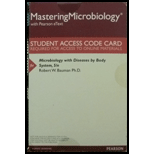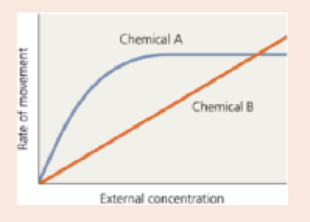
Microbiology: With Diseases By... -Access
5th Edition
ISBN: 9780134626369
Author: BAUMAN
Publisher: PEARSON
expand_more
expand_more
format_list_bulleted
Concept explainers
Textbook Question
Chapter 3, Problem 3VI
A scientist who is studying passive movement of chemicals across the cytoplasmic membrane of Salmonella enterica serotype Typhi measures the rate at which two chemicals diffuse into a cell as a function of external concentration. The results are shown in the following figure. Chemical A diffuses into the cell more rapidly than does B at lower external concentrations, but the rate levels off as the external concentration increases. The rate of diffusion of chemical B continues to increase as the external concentration increases.
- a. How can you explain the differences in the diffusion rates of chemicals A and B?
- b. Why does the diffusion rate of chemical A taper off?
- c. How could the cell increase the diffusion rate of chemical A?
- d. How could the cell increase the diffusion rate of chemical B?

Expert Solution & Answer
Want to see the full answer?
Check out a sample textbook solution
Students have asked these similar questions
This graph shows facilitated diffusion of a compound across a cytoplasmic membrane and into a cell. As the external concentration of the compound is increased, the rate of uptake increases until it reaches a point where it slows and then begins to plateau. This is not the case with passive diffusion, where the rate of uptake continually increases as the solute concentration increases. Why does the rate of uptake slow and then eventually plateau with facilitated diffusion?
Which of the following scenarios would result in the SLOWEST rate of diffusion?
A. 1 molecule on the outside of a cell membrane, while 10 molecules are inside
B. 8 molecules on the outside of a cell membrane, while 5 molecules are inside
C. 12 molecules on the outside of a cell membrane, while 2 molecules are inside
D. 20 molecules on the outside of a cell membrane, while 10 molecules are inside
In the diffusion of dye in water experiment, what variable did we test for that affected rate of diffusion? How did it affect rate of diffusion?
a
viscosity; higher viscosity results in slower rate of diffusion
b
temperature; higher temperature results in slower rate of diffusion
c
viscosity; higher viscosity results in faster rate of diffusion
d
temperature; higher temperature results in faster rate of diffusion
Chapter 3 Solutions
Microbiology: With Diseases By... -Access
Ch. 3 - Prob. 1TMWCh. 3 - In 1985, an Israeli scientist discovered the...Ch. 3 - Why is a pilus a type of fimbria, but a flagellum...Ch. 3 - Why is the microbe illustrated in Figure 3.2 more...Ch. 3 - The Big Game College sophomore Nadia is a star...Ch. 3 - When the bacterium Escherichia coli is grown in a...Ch. 3 - Prob. 6TMWCh. 3 - Why do scientists consider bacterial and archaeal...Ch. 3 - Why did scientists in the 19th and early 20th...Ch. 3 - Why do some scientists consider archaea, which are...
Ch. 3 - Why are eukaryotic glycocalyces covalently bound...Ch. 3 - Many antimicrobial drugs target bacterial cell...Ch. 3 - Colchicine is a drug that inhibits microtubule...Ch. 3 - A cell may allow a large or charged chemical to...Ch. 3 - Which of the following statements concerning...Ch. 3 - A 9 + 2 arrangement of microtubules is seen in...Ch. 3 - Which of the following is most associated with...Ch. 3 - Which of the following is not associated with...Ch. 3 - Which of the following is true of Svedbergs? a....Ch. 3 - Which of the following statements is true? a. The...Ch. 3 - Prob. 8MCCh. 3 - Bacterial flagella are ______________. a. anchored...Ch. 3 - Prob. 10MCCh. 3 - A Gram-negative cell is moving uric acid across...Ch. 3 - Gram-positive bacteria _______________. a. have a...Ch. 3 - Endospores ________________. a. are reproductive...Ch. 3 - Prob. 14MCCh. 3 - Dipicolinic acid is an important component of...Ch. 3 - Match the structures on the left with the...Ch. 3 - Match the term on the left with its description on...Ch. 3 - Label the structures of the following prokaryotic...Ch. 3 - Label each type of flagellar arrangement.Ch. 3 - A scientist who is studying passive movement of...Ch. 3 - Describe (or draw) an example of diffusion down a...Ch. 3 - Sketch, name, and describe three flagellar...Ch. 3 - Prob. 3SACh. 3 - The term fluid mosaic has been used in describing...Ch. 3 - A local newspaper writer has contacted you, an...Ch. 3 - Prob. 6SACh. 3 - Compare bacterial cells and algal cells, giving at...Ch. 3 - Contrast a cell of Streptococcus pyogenes (a...Ch. 3 - Differentiate among pili, fimbriae, and cilia,...Ch. 3 - Prob. 10SACh. 3 - Prob. 11SACh. 3 - Prob. 12SACh. 3 - What is the function of glycocalyces and fimbriae...Ch. 3 - Prob. 14SACh. 3 - Compare and contrast three types of passive...Ch. 3 - Prob. 16SACh. 3 - Prob. 17SACh. 3 - Prob. 18SACh. 3 - Prob. 1CTCh. 3 - Methylene blue binds to DNA. What structures in a...Ch. 3 - Prob. 3CTCh. 3 - Prob. 4CTCh. 3 - A researcher carefully inserts an electrode into...Ch. 3 - Prob. 6CTCh. 3 - An electron micrograph of a newly discovered cell...Ch. 3 - An entry in a recent scientific journal reports...Ch. 3 - Prob. 9CTCh. 3 - Prob. 10CTCh. 3 - Prob. 11CTCh. 3 - Prob. 12CTCh. 3 - Prob. 13CTCh. 3 - Prob. 14CTCh. 3 - Using the following terms, fill in the following...
Knowledge Booster
Learn more about
Need a deep-dive on the concept behind this application? Look no further. Learn more about this topic, biology and related others by exploring similar questions and additional content below.Similar questions
- A microbe that is completely dependent on host cells for processes like transcription and translation” would describe which of the following? Select one: a. An intracellular protist parasite. b. A virus. c. A commensal bacterium. d. An intracellular bacterial pathogen. poiling yourself, you decide to eat at a fancy fish restaurant. One type of fish must be prepared carefully to remove a toxin that can cause paralysis. What type of channel is the toxin likely to affect? Select one: a. Voltage. b. Terminal. c. Mechanical. d. Positive.arrow_forwardFor a lab on diffusion and osmosis, where a egg yolk was placed in a cup water the following question asks Consider a scenario in which the size of an egg yolk remains unchanged after in water soaking for an hour. What are two possible explanations as to why this occurs? What would two reasons be for the yolk to be unchanged after a hour in water?arrow_forwardOne of the following is TRUE? A. The transport of Na+ across cell membranes depends solely on concentration gradient B. The transport of sucrose across cell membranes depends solely on concentration gradient C. The transport of K+ across cell membranes depends solely on concentration gradient D. The transport of Ca2+ across cell membranes depends solely on concentration gradient E. A & Carrow_forward
- From the list below choose all which apply to the process of diffusion. A. Requires energy B. Passive process C. Transports with concentration gradient D. Powered by random motion E. Transports against concentration gradient.arrow_forwardWhich of the following methods of transport is being used to transfer the substance into the cell in the accompanying graph? a. diffusion down a concentration gradient b. osmosis c. facilitated diffusion d. active transport e. vesicular transport f. It is impossible to tell with the information provided.arrow_forwardThe principal force driving movement in diffusion is______. a. temperature b. particle size c. concentration gradient d. membrane surface areaarrow_forward
- Propose an experiment that would distinguish pore-mediated diffusion (e.g.,by gramicidin) from carrier-mediated diffusion (e.g., by valinomycin).arrow_forwardActive transport pumps are used to move sodium ions across the membranes of gill cells in freshwater fish species. Which of the following statements about the pumps is accurate?Explain. a) There are specific binding sites for sodium ions on the pump b) They require osmosis to carry the sodium ions into the cell c) This is an example of passive diffusion and ATP is required d) Their lipid based structure allows it to embed in the cell membranearrow_forwardThe experiment described in Figure 11-16 was performed at 37 °C. If the experiment were carried out at 10 °C, what effect would you expect on the rate of diffusion? Why?arrow_forward
- The surface area to volume ratio affects the ability of the cell to exchange nutrients and waste products with the outside environment. Many factors affect the movement of molecules across the cell membrane, including membrane thickness, temperature, pressure, concentration gradient, molecular mass, distance travelled, solvent properties and surface area of the cell. In general, according to Einstein’s approximation equation (Equation 1), diffusion time is inversely proportional to the to the diffusion coefficient (D), where t is time and x is distance travelled. The diffusion coefficient is unique to each type of molecule and is determined experimentally. Waste products such as carbon dioxide (CO2) pose a unique problem to cells as their accumulation may be lethal. Exchange with the external environment is dependent upon the distance the waste must travel; for a round cell this will be up to half the cell diameter. Using the diffusion coefficient (D) for carbon dioxide (1.97 × 10-5…arrow_forwardThe principal force driving movement in diffusion is __________. a. temperature b. particle size c. concentration gradient d. membrane surface areaarrow_forwardIn cell culture experiments, when you add the purified toxin to host cell monolayers, the host cells die. The toxin-infected host cells do not lyse, but the cells have collapsed and show a significant loss of water and ions. The toxin is translated and produced by the bacterium as a single polypeptide. However, cellular fractionation of the host cells into cytosolic and membrane fractions reveals that a portion of the toxin is present in the membrane fraction and another portion is in the cytosolic fraction. Based on these results, answer the following questions: A. What type of toxin have you identified? 2 B. How does this toxin function to kill host cells?arrow_forward
arrow_back_ios
SEE MORE QUESTIONS
arrow_forward_ios
Recommended textbooks for you
 Human Physiology: From Cells to Systems (MindTap ...BiologyISBN:9781285866932Author:Lauralee SherwoodPublisher:Cengage Learning
Human Physiology: From Cells to Systems (MindTap ...BiologyISBN:9781285866932Author:Lauralee SherwoodPublisher:Cengage Learning Concepts of BiologyBiologyISBN:9781938168116Author:Samantha Fowler, Rebecca Roush, James WisePublisher:OpenStax College
Concepts of BiologyBiologyISBN:9781938168116Author:Samantha Fowler, Rebecca Roush, James WisePublisher:OpenStax College

Human Physiology: From Cells to Systems (MindTap ...
Biology
ISBN:9781285866932
Author:Lauralee Sherwood
Publisher:Cengage Learning

Concepts of Biology
Biology
ISBN:9781938168116
Author:Samantha Fowler, Rebecca Roush, James Wise
Publisher:OpenStax College
The Cell Membrane; Author: The Organic Chemistry Tutor;https://www.youtube.com/watch?v=AsffT7XIXbA;License: Standard youtube license